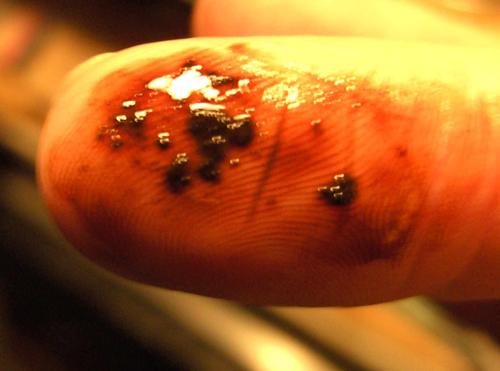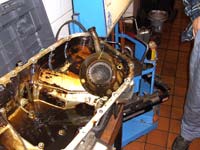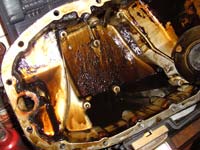The Engine Oil Bible
Sludge : A Case Study
In January 2007 I was contacted by a reader (Mike) with a curious problem. As he described it, "small 'flakes' on the dipstick....that disappeared when rubbed between my fingers". Not entirely sure what to expect, I asked if he could take a photo and email it to me, which he did:

We figured out pretty quickly that Mike was seeing sludge on his dipstick. This was a dilemma because he'd only just bought the car - a Saab 9 5 Aero with 42,000 miles on it. At this point Mike had one of three options open to him. First, take the car back. Second, let his dealer take it to their regular mechanic and let them sort it out. And finally, get Mike to take it to his own mechanic who he trusted, but that would absolve the dealer from any further responsibility to damage caused by this situation. Whatever happened, the sump would need to be dropped and the engine would need flushing.
I recommended that Mike go with option 2 and that he go along camera-in-hand to document what the dealer mechanic found. For those of you with a Saab, this is what can happen when you succumb to sludge. Click on the pictures for larger (1600x1200) versions:



The second image shows the most worrisome aspect of sludge in this case. The oil pickup that dips into the sump is covered with a mesh strainer - not unusual. The sludge has peppered the strainer with little clumps and reduced its capacity to pick up oil. This can lead to a starved oil pump which in turn would normally lead to reduced oil pressure and capacity in the upper part of the engine. The end result of that is usually a seized engine - where the metal parts rub together with no lubrication and basically weld themselves together.
Mike's Saab 9 5 Aero is now sludge-free, and hopefully will stay like that with regular, decent oil changes. At least the problem was caught early and resolved. If you want a true horror story, you need look no further than this page to see what happens when sludge isn't caught early on.
Sulfated Oil
I was contacted by another reader, Marc, after they saw this page. He had another idea worth considering.
Carbon deposits are never soft nor yield under finger pressure. The deposits you are almost assuredly finding (based on that description) is sulfated ash, which has the properties you describe (soft, crumble under finger pressure) and is common in many American & Canadian modern oils; without burnt oil discoloring it, it normally has a light-gray to pale-tan coloration which may become visible if you shear a bit of the debris. Unfortunately, the API SH-SL ratings are not strict enough on sulfated ash content for these kinds of engines (API SM may address this; I haven't looked into it). The problem occurs most often in high-revving, hot engines, particularly those designed outside the North American continent. Why? Because most of the rest of the world utilizes oils that come from low-sulfer content sources (golden light), while many north American oils are created from native stocks, which are particularly high in sulfur content (esp. those reclaimed from Canadian sand fields and the pacific rim wells). With the feds pushing for reduced sulfer content in the diesel fuels & gasolines in the newest EPA pollution tiers, these high-sulfer oil sources are being pushed heavier for oil production (as verses to fuel production) exacerbating the issue.
It's an issue that's fairly well known in some motorcycling circles, and the Japanese motorcycle industry recognized the issue very early on, creating a new oil specification specific to their needs (one, that among other things, caps the sulfated ash content very low): JASO-MA, recently revised further into to JASO-MA1 & JASO-MA2. Although the specifications of JASO-MA/JASO-MA1 oils are particularly good in sulfer content & high-temp behavior, it's not good in other ways for modern car engines which call for very light weight oils with friction modifiers (such as most late model cars), so it should not be used as a substitute. I'm not sure about JASO-MA2, which may meet your needs, or other JASO-ratings. Alternatively, Mobil 1 products have been very low in sulfated ash content in the past and may be the best bet for your situation to help combat the problems (they also, at least in their motorcycle oil products, have the highest vapor temp of any oil on the market, meaning temp-driven sludging is virtually zero unless the temp of the oils exceed 500 degrees F).
For motorcyclists, the sulfated ash content poses a secondary issue that may not affect your engines: high sulfated ash contents also means higher quantities of sulfuric acid if water gets introduced into the oil (such as from condensation within the galley spaces); since most motorcycle engines share the oil with both the engine and the transmission, the sulfuric acid is particularly problematic as the metals used in the transmission selector forks are made of cheaper steels that don't stand up to the acid nearly as well as most engine components.
quantities of sulfuric acid if water gets introduced into the oil (such as from condensation within the galley spaces); since most motorcycle engines share the oil with both the engine and the transmission, the sulfuric acid is particularly problematic as the metals used in the transmission selector forks are made of cheaper steels that don't stand up to the acid nearly as well as most engine components.
Have a look at Marc's motorcycle oil FAQ for further reading.
